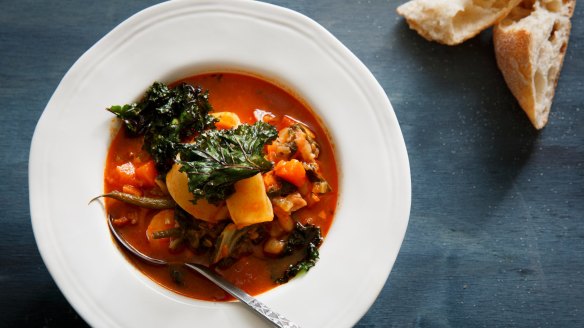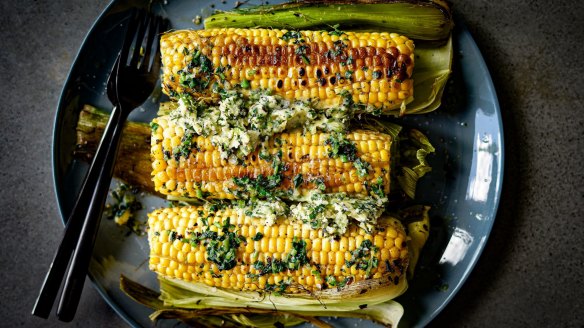The thrifty 50: Tips to reduce food waste

Buy a food dehydrator (or use your oven) to turn surplus fruit and veg into lunchbox-friendly dried snacks. Berries, bananas, apples and stone fruit are great for home-made trail mix or for making into fruit leather. Dried vegies like carrots, mushrooms and peas can be added to stews and soups. Kale tastes amazing in chip form, too. Megan Johnston
Wash and freeze unused green leek tops, and celery and carrot tops and tails, and use them to make stock once you reach critical mass. Store parmesan rinds in a lidded container in the freezer and slip them into the pot when making stock, minestrone, risotto or ragu to add extra umami. Remove before serving. Roslyn Grundy
Everyone in the family has their own favourite pasta shape, right? So there are various packs and jars of spaghetti, farfalle and penne in the pantry, of various quantities. Once a month or so, make "pasta mista" for dinner, and cook them all at once (until the thickest one is al dente, the others will survive). It's fun to eat, and no uselessly small amounts of pasta are left in the cupboard. Also, always finish the bottle of wine to avoid any waste, hehe. Jill Dupleix
Buy beetroot by the bunch, and serve the beets roasted as a hot vegetable or pickle them for future use. Save the leaves, wash well and cook lightly in salted boiling water. Drain, toss with olive oil and vinegar, and top with a fried egg. Similar story with silverbeet – serve the stalks as a vegetable in their own right under a melting sauce of cheese (or treat them like pasta, above). Terry Durack
Make a big batch of soup with whatever limp vegetables are left in your crisper at the end of the week (and then boast about how many varieties of veg are in your soup to whoever will listen: "Mum I made 14-veg soup last night, yes, with red lentils too, go me.") Freeze whatever soup you can't eat in the next couple of days, and add a splash of cream or milk if it's just too virtuous. Andrea McGinniss
Thinly slice yesterday's baguette and bake in a low oven to create croutons. You can further up the virtue (and the flavour) by taking the last teaspoons of ground spices in jars, mixing them with olive oil to make a paste, then painting it on your baguette slices to make spiced crisps. Dani Valent
There is no such thing as leftover bread. Place stale torn-up bread in a food processor and turn into fine-medium crumbs. Add fresh herbs from the garden, place in a freezer bag and store in the freezer. Use the crumbs to top gratins, fry and add to pasta or in a salad. Richard Cornish
Understand the difference between "use by" and "best by". Use-by dates are for perishables such as chicken and should be adhered to. Best-by dates are for non-perishable products such as pasta. A product past its best-by date will still be safe to consume, just check for obvious deterioration or insect infestation. RC
Be like a shopkeeper and rotate stock. Put new products to the back of the pantry and older ones to the front. RC
Buy takeaways you can dish out over several days or team with affordable sides. Burgers won't survive an extra day or two so steer towards curries, pasta or noodle dishes. You can mop up Indian dishes with fresh roti, or serve with pappadums, for example, or make a frittata from noodles or pasta. Leftover curry makes an amazing jaffle filling, too. MJ

If I have some soft herbs getting past their prime, I'll turn them into herb butters. Having a stick in the freezer brings excitement to grilled fish, fancies up toast with eggs on the weekend or can jazz up some boiled potatoes. Or use it to slip under the skin of a chicken you are about to roast (see Rachel Khoo's recipe). Soften butter, chop herbs, blitz together, roll and freeze. Try and use one herb or no more than two complimentary flavours – parsley and tarragon, chives and mint – to avoid a muddy taste. Emma Breheny
Want a constant source of fresh spring onions? Take a bunch from the shop and plant the root pieces in a pot with potting mix, or a small jar of water. Keep the jar in a sunny spot, and change the water weekly. Snip off the stalks as they grow - they'll keep reshooting for months. MJ
Look past the prime parts of vegetables and herbs. Coriander stems, sliced ultra-thin, have even more guts than the leaves – scatter them onto tacos or blitz them into curry paste. Carrot tops make a peppery pesto. Celery hearts are incredible braised in stock and butter or shaved, drowned in vinegary dressing and piled on toast schmeared with blue cheese. Then when spring hits and you're (hopefully) buying peas and broad beans in the pod, save the shells to make a sweet vegetable stock to stir into bright, sunny risottos. David Matthews
Appears in these collections
The best recipes from Australia's leading chefs straight to your inbox.
Sign up